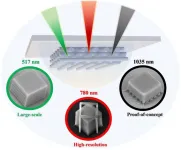Wavelength-independent and photoinitiator-free laser 3D nanolithography
2024-10-09
(Press-News.org)
Laser direct writing (LDW) employing multi-photon 3D polymerisation is a scientific and industrial lithography tool used in various fields such as micro-optics, medicine, metamaterials, programmable materials, etc., due to the fusion of high-throughput and fine features down to hundreds of nm. Some limitations of technology applicability emerge from photo-resin properties as any material modifications can strongly affect its printability due to applied photoexcitation conditions.
In a paper published at Light: Advanced Manufacturing, a team of scientists, led by Professor Mangirdas Malinauskas from Laser Research Center at Vilnius University, Vilnius, Lithuania, coworkers Dr. Maria Farsari (Institute of Electronic Structure and Laser, Foundation for Research and Technology-Hellas, Heraklion, Greece) and Prof. Saulius Juodkazis (Optical Sciences Centre and ARC Training Centre in Surface Engineering for Advanced Materials (SEAM), School of Science, Swinburne University of Technology, Melbourne, Australia) present wavelength-independent 3D polymerisation using low peak power laser oscillators. Previously this was validated only using amplified laser sources which raises the equipment price sifnificantly.
High pulse repetition rate oscillators were employed for rapid LDW to advance additive manufacturing of non-photosensitized materials. Namely, the widespread SZ2080TM photoresist and its derivatives varying organic-inorganic substance ratio was optically 3D printed without use of any photo-initiator. Wavelengths of 517 nm, 780 nm, and 1035 nm are shown to be suitable for producing 300 nm polymerized features even at high – up to 105 μm/s – linear writing speeds. This matches with the commonly used manufacturing parameters. It was found that variation of organic-inorganic ratio in hybrid material results in shift and decrease of the dynamic fabrication window, yet essentially not prohibiting the photo-structuring. Controlled energy deposition per focal volume was achieved due to localized heating enabling efficient 3D printing. Such spatio-selective photo-chemical cross-linking widens optical manufacturing capacity of non-photo-sensitive materials – meaning all cross-linkable polymers, not only light-sensitive photo-polymers.
“We demonstrate that ultrafast laser oscillator of any common wavelength can: 1) induce localized photo-crosslinking enabling true 3D printing; 2) it can be achieved even without the usage of photoinitiator. This was experimentally validated using different commercial non-amplified femtosecond laser sources. This in turn triggers further research to apply X-photon approach towards studying other materials. But its already a breakthrough in laser 3D additive manufacturing enabling use of various lasers and non-photosensitized polymer materials. Importantly, it opens opportunity to produce highly-transparent micro-optics, low-toxicity biomedical scaffolds, and combine green chemistry with green photonics for sustainable additive manufacturing.”
“Since the switching to X-photon excitation mechanism from two-photon absorption does not require significantly higher laser powers (sub-1 nJ pulses are sufficient) or decrease of fabrication throughput (10 mm/s writing velocity was routinely achieved), it is expected to be immediately uptaken by many laboratories worldwide and introduced in industry.” scientists added.
END
[Attachments] See images for this press release:

ELSE PRESS RELEASES FROM THIS DATE:
2024-10-09
Duke-NUS alumnus Dr Marjorie Hoang (Class of 2023) and her mentor, Professor Pierce Chow, have brought clarity to the complex decision-making process patients diagnosed with intermediate-stage liver cancer and their doctors face by creating an algorithm that can accurately calculate the likely overall survival and recurrence-free survival following surgery.
Dr Hoang, whose interest in the liver stems from her first year at Duke-NUS, undertook a transformative third-year research project under the guidance of Prof Chow, a senior consultant specialising in liver cancer surgery at the National Cancer Centre ...
2024-10-09
Engineers have worked out how to give robots complex instructions without electricity for the first time which could free up more space in the robotic ‘brain’ for them to ‘think’.
Mimicking how some parts of the human body work, researchers from King’s College London have transmitted a series of commands to devices with a new kind of compact circuit, using variations in pressure from a fluid inside it.
They say this world first opens up the possibility of a new generation of robots, whose bodies could operate independently ...
2024-10-09
University of Queensland researchers are calling for reforms to Australia’s environmental laws, as threatened fish species continue to be legally exported.
Their work has identified four species that have been listed under Australia’s Environment Protection and Biodiversity Conservation (EPBC) Act and legally exported from Australia: the orange roughy, blue warehou, school shark and southern bluefin tuna.
Despite being listed as threatened under Australia’s under-review EPBC Act, UQ PhD candidate Rosa Mar Dominguez-Martinez said these fish continue to be exported.
“Since the inception ...
2024-10-08
Irvine, Calif., Oct. 8, 2024 — A research team led by the University of California, Irvine has engineered an efficient new enzyme that can produce a synthetic genetic material called threose nucleic acid. The ability to synthesize artificial chains of TNA, which is inherently more stable than DNA, advances the discovery of potentially more powerful, precise therapeutic options to treat cancer and autoimmune, metabolic and infectious diseases.
A paper recently published in Nature Catalysis describes how the team created an enzyme called 10-92 that achieves ...
2024-10-08
Rosalee Hellberg, an associate professor in Chapman University’s Food Science Program, and her research team have made a significant breakthrough in the fight against adulteration in dietary supplements. Effective methods for identifying adulteration and fraud have remained elusive. Now, a new study of 50 commercially available ginseng products has found surprising results.
Ginseng products are vulnerable to fraud, with cheaper plant materials substituted for genuine ingredients, posing risks to consumer health and safety. Using a novel combination of DNA testing techniques, the researchers detected undeclared plant species in nearly half of the 50 ginseng supplements tested.
The ...
2024-10-08
The U.S. Department of Energy (DOE) has awarded DOE’s Argonne National Laboratory funding as part of its Artificial Intelligence (AI) for Scientific Research program. These grants will drive the development of cutting-edge AI technologies that promise to accelerate scientific discovery while preserving data privacy and improving energy efficiency.
Argonne Computational Mathematician Kibaek Kim received funding for the project called Privacy-Preserving Federated Learning for Science: Building Sustainable and Trustworthy Foundation Models. This project ...
2024-10-08
Despite considerable progress in the discovery and development of new cancer drugs, there are significant disparities in both the availability and timeliness of these medicines worldwide, with poorer countries missing out, suggests a global analysis of new drug launches between 1990 and 2022, published in the open access journal BMJ Global Health.
Few new cancer drugs were launched in lower-middle or low income countries, and the gap between rich and poor nations widened over the three decades, the analysis shows.
Such inequities may help explain poor cancer outcomes in many countries, particularly those ...
2024-10-08
Waiting more than 4 hours in emergency care for treatment is linked to heightened risks of death and a longer hospital stay for hip fracture patients, reveals a single centre study, published online in Emergency Medicine Journal.
The waiting time for more than 1 in 3 of these patients exceeded the 4 hour national standard, which now requires that 76% of emergency department patients must either be discharged or admitted to hospital within that time frame.
By the age of 80 an estimated third of women and 17% of men will have ...
2024-10-08
A change in policy may be helping to drive a rise in treatment-resistant vaginal thrush, amid significant yearly increases in the prevalence of fungal infections caused by fungal Candida species, suggests the first study of its kind, published online in the journal Sexually Transmitted Infections.
While the exact reasons for these trends aren’t yet clear, they follow a shift in clinical practice, with the aim of reducing laboratory workload, say the researchers. Family doctors in primary care are now encouraged to treat vaginal thrush empirically—on signs and symptoms alone, rather than on confirmatory lab test results.
Vaginal thrush is ...
2024-10-08
EMBARGOED UNTIL 23:30 UK TIME TUESDAY 8 OCTOBER 2024
Peer-reviewed / Data analysis / People
Heat stress may still affect babies once born, first evidence suggests
Exposure to high levels of heat may both impact the growth of foetuses during pregnancy and infants up to the age of two, a new analysis suggests.
The study is the first of its kind to show that heat stress may impact the development of babies after they’re born and adds to previous research by the team showing the impact of heat stress on foetal development.
The research, which examined data from infants and their mothers collected during a clinical trial in ...
LAST 30 PRESS RELEASES:
[Press-News.org] Wavelength-independent and photoinitiator-free laser 3D nanolithography


